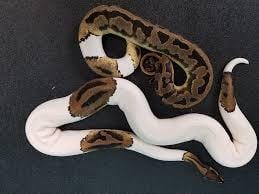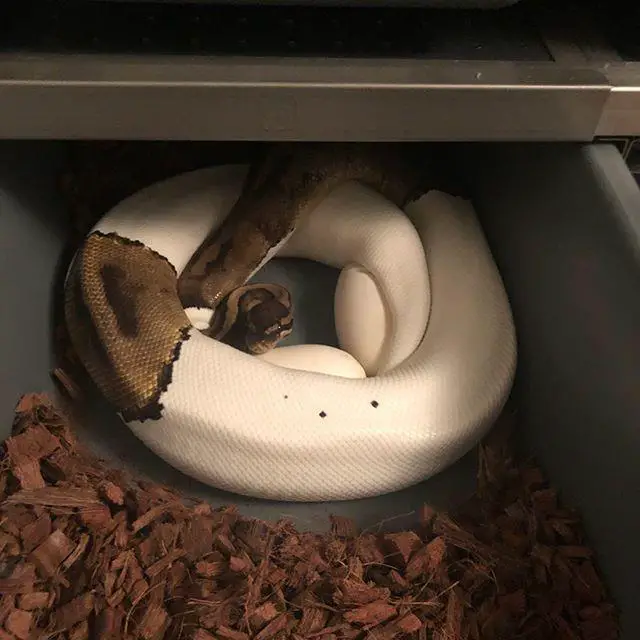The piebald ball pythons are sexually mature as soon as they reach their second year. Some snake breeder’s goal is to breed piebald because of its physical characteristics that can be sold for thousands of dollars. If their coloration is what you are after, it may be difficult to achieve it since breeding them doesn’t mean that you will have a 90% piebald snake even though you will breed two piebalds because the amount of white pigmentation on their body is just a random occurrence. To achieve a perfect combination of white patches in their bodies, the process of mutation is needed.
A female piebald python can lay up to 11 eggs. When these eggs hatches, expect that each piebald python is unique in terms of their pigmentation patterns. Inbreeding them, the first thing that you need to ensure first that the female is ready to lay eggs. In this article, we’ll learn the basic process of how these piebald pythons are bred and reproduce.
How to Prepare Breeding
1. Brumation Period
Inbreeding two piebald pythons, there are preparations that need to be done. You may need to prepare their bodies for the breeding season by building a hibernation chamber for them to go through a brumation period, which is an artificial winter. They are used to breeding during spring, which is after a few months of cold. The brumation period is a way for your piebald pythons to develop the strength of the labor process, especially for females.
To do this, you may need to simulate a cold temperature into their enclosure. Lower down the temperature level in their enclosure by starting at 78° to 80° Fahrenheit and make sure that there is enough humidity level. You will notice a change in their appetite, but you are still required to feed them about once every two weeks. They may hide and burrow, so make sure that their cage has the right substrate that is about five to ten inches. After how many days, even lower the temperature level at 55° to 60° Fahrenheit.
2. Introducing the male and female

After the brumation period that will last for about 3 months, you may now introduce the male and the female snake. It is ideal that it is the males that you will take into the female’s enclosure, but research shows that it doesn’t matter whether you’ll take the female into the male’s enclosure and vice versa. Expect that there may be some fighting, but the male will still be fully aware that there is a female in his surroundings.
It is the male who will slither up with the female to show to the female that he wants to mate with her. They may still show signs of courtship, but as soon as the female is already comfortable through their body signs, they may already intertwine, to begin with, the mating process. They may be intertwined for hours just don’t disturb them.
When they are done, separate the two and give them a little time to rest before you reintroduce them again for the breeding process to be successful. When you notice that the female lost interest with the male, it is a sign that she is now developing eggs. All you have to do is to wait for the females to lay eggs. They may have up to 11 eggs.
Taking Care of the Eggs

In captivity, the eggs may be incubated either by their mothers or through artificial incubation. To ensure that almost all eggs will hatch, you may need to artificial incubation. The incubators that you can use can either be purchased or improvised as long as it can give at least 88 to 90 degrees Fahrenheit for the embryo to develop and hatch. The incubation process takes about 80 to 105 five days. As soon as the eggs hatch, make sure that there is a prepared housing for them.
Tips in Breeding Piebald Python
- Before breeding, make sure to know the sexes of your snakes through different sexing methods such as probing method, pooping method, and sexual dimorphism.
- They are already sexually mature by age two, but for the breeding process to be successful, they should be at the right breeding weight, especially for the females; that is why before the brumation period, they should be well fed to have enough stored energy to give them strength.
- During the brumation period, you will be lowering down the temperature level bit be sure to stick with the ideal temperature since exposing them to too low temperature may cause harm to their health, and it may cause stress to their bodies that may delay reproduction.
- It is normal for snakes to be aggressive if they just introduced, but this aggression should only last for minutes and that they should not be hurting each other. If the aggression last and it is not curbed, it is advisable to postpone breeding for the meantime because there is a possibility that they are not yet ready.
- Make sure not to interrupt their copulation to ensure that the female will be impregnated easily without the need for reintroduction.
- Once the eggs have been laid and you noticed that it is not being incubated by the female piebald python, it is time to remove the eggs and do artificial incubation. Mark the side of the egg that is facing upwards so as not to disrupt the embryo’s position.
Final Thoughts
Piebald ball pythons are considered a beginner snake, but if you decided to breed them, make sure that you can fulfill their needs for about 25 to 30 years. Like doing it to other animal species, there is a process that you need to follow in order for the breeding process to be successful. All environmental factors must be kept ideal from the temperature level up to the willingness of both snakes to bred. It may be a complicated process, but as soon as you successfully bred piebald pythons, it will surely be rewarding in your part as a breeder.



